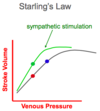S5) Circulatory Shock Flashcards
What is haemodynamic shock?
Haemodynamic shock is an acute condition of inadequate blood flow throughout the body due to a catastrophic fall in arterial blood pressure
What are the causes for the catastrophic drop in blood pressure which leads to haemodynamic shock?

Identify and define three different types of shock occurring due to a fall in cardiac output
- Cardiogenic shock – ventricle cannot empty properly
- Mechanical shock – ventricle cannot fill properly
- Hypovolaemic shock – reduced blood volume leads to poor venous return
What is cardiogenic shock?
Cardiogenic shock is the acute failure of the heart to maintain cardiac output (pump failure)
Identify 3 potential causes for cardiogenic shock
- Myocardial infarction (damage to left ventricle)
- Serious arrhythmias
- Acute worsening of heart failure
What are the consequences of cardiogenic shock?
- CVP normal/raised
- aBP lowered
- Tissues poorly perfused
I. Coronary arteries (exacerbates problem)
II. Kidneys (reduced urine production)
Cardiac tamponade is an example of mechanical shock.
What is this condition?
Cardiac tamponade is when blood/fluid builds up in pericardial space, restricting the filling of both sides of the heart and limiting the end diastolic volume
What are the consequences of cardiac tamponade?
- High CVP
- Low aBP
- Continued electrical activity
A pulmonary embolism is another example of mechanical shock.
What are the consequences of this?
- High pulmonary artery pressure → right ventricle cannot empty
- High CVP → reduced return of blood to the left heart
- Low LAP
- Low aBP
State two characteristic symptoms of mechanical shock due to PE
- Chest pain
- Dyspnoea
In four steps, explain how an embolus reaches the lungs
⇒ Deep vein thrombosis
⇒ Portion of thrombus breaks off
⇒ Embolus travels in venous system to right side of the heart
⇒ Pumped out via pulmonary artery to lungs
What is hypovolaemic shock?
Hypovolaemic shock is a state of shock due to reduced blood volume, most commonly due to haemorrhage
The severity of hypovolaemic shock is related to amount and speed of blood loss.
How does the shock vary with amount of blood loss?
- < 20% blood loss unlikely to cause shock
- 20-30% blood loss show some signs of shock response
- 30-40% bloow loss shows substantial decrease in mean aBP and serious shock response
Explain what happens during a haemorrhage
⇒ Venous pressure falls
⇒ Cardiac output falls (Starling’s Law)
⇒ Arterial pressure falls

Describe the compensatory response observed in hypovolaemic shock
⇒ Low aBP detected by baroreceptors
⇒ Increased sympathetic stimulation
⇒ Tachycardia, increased contractlity
⇒ Peripheral vasoconstriction and venoconstriction


